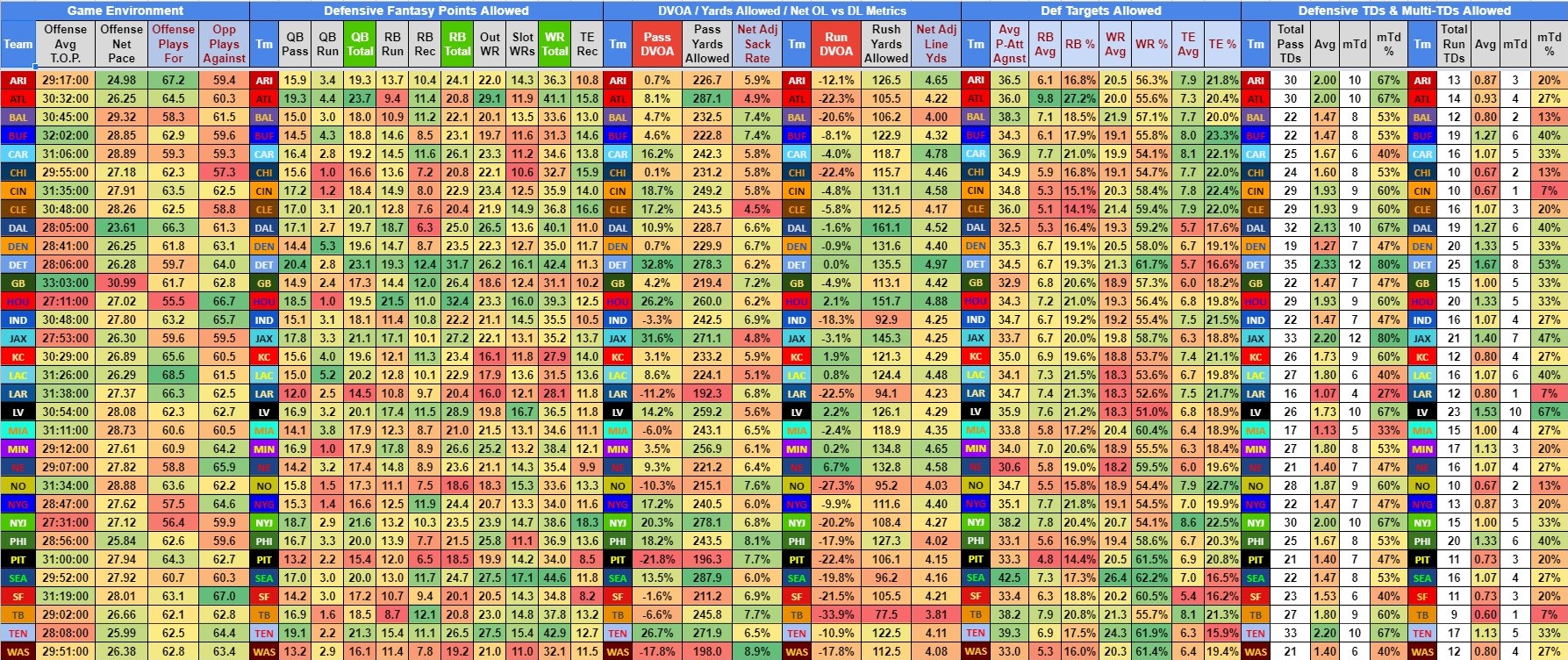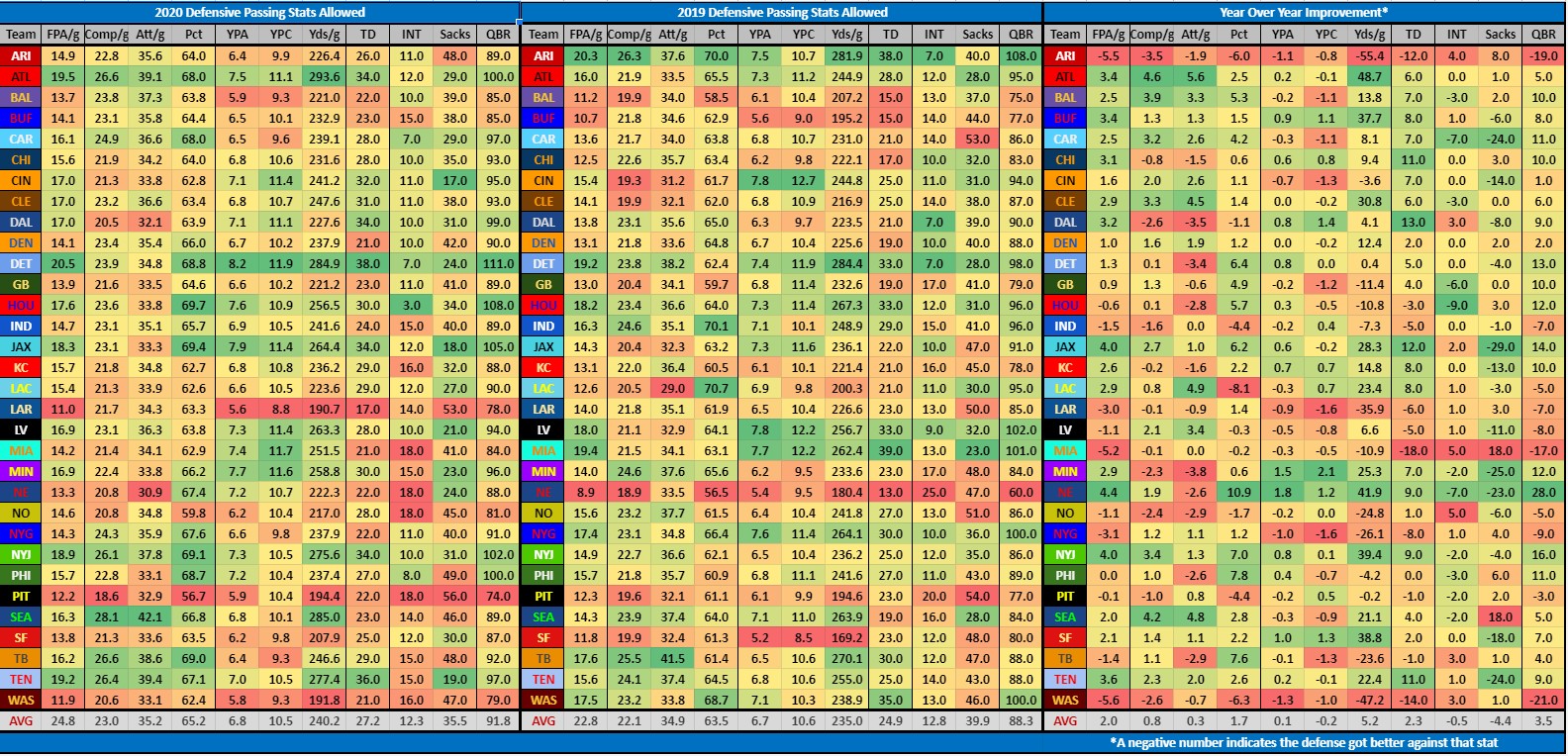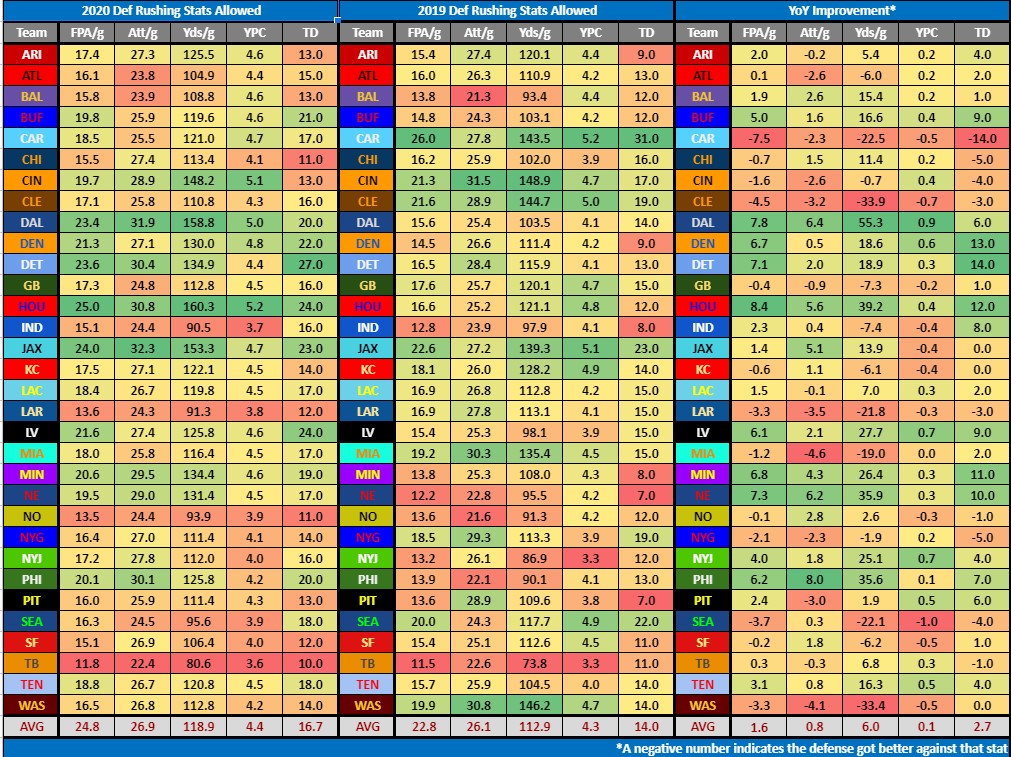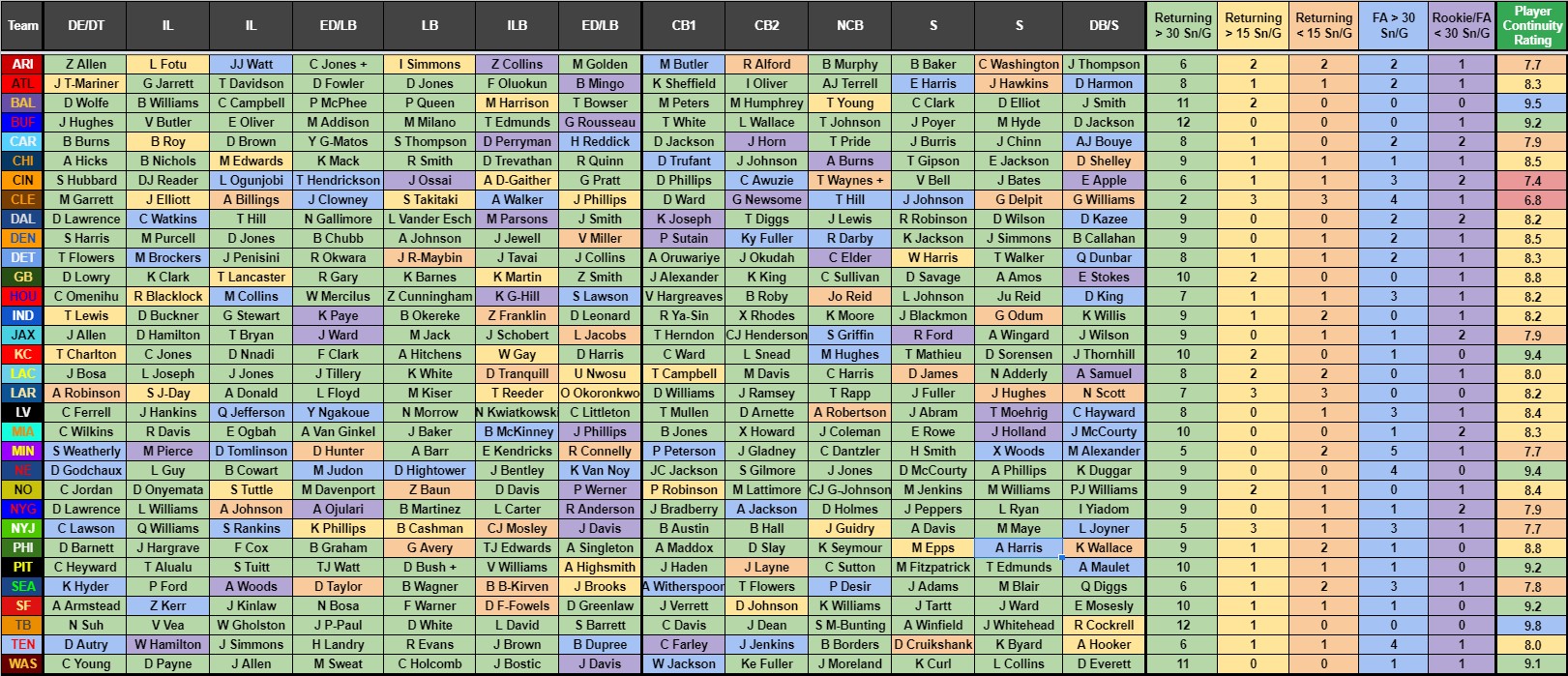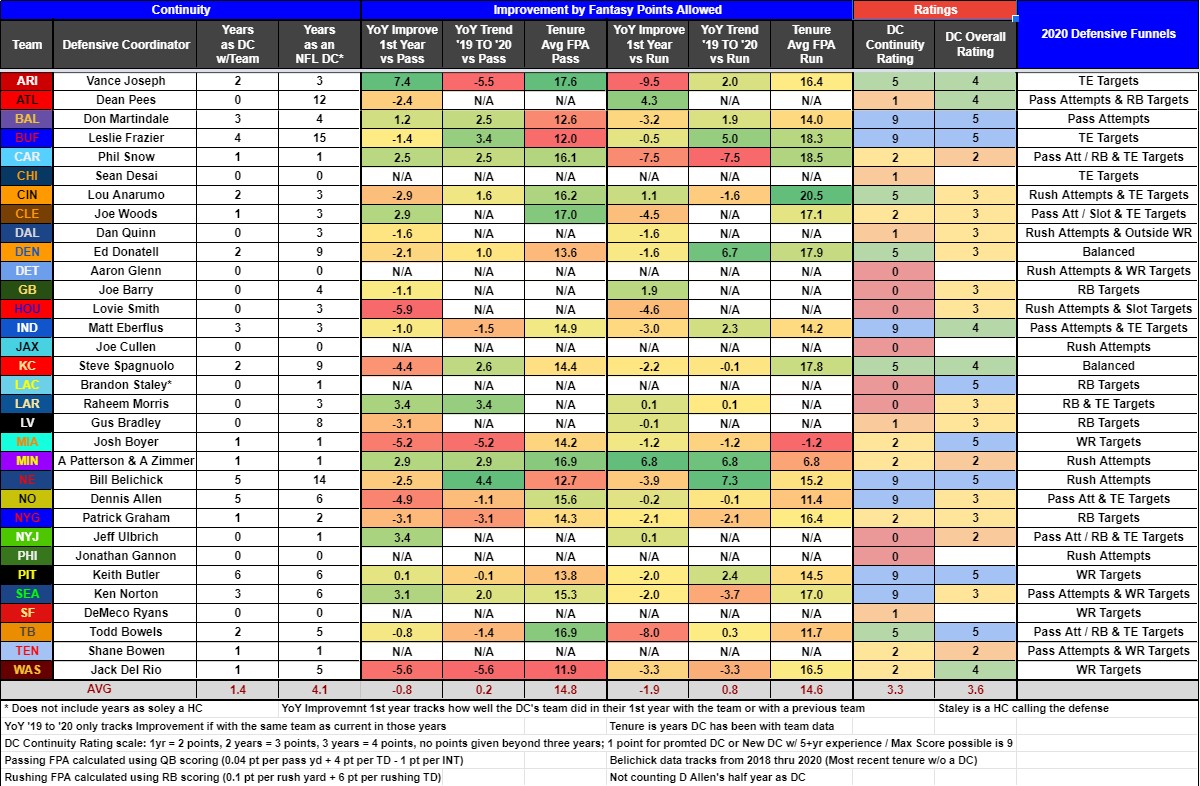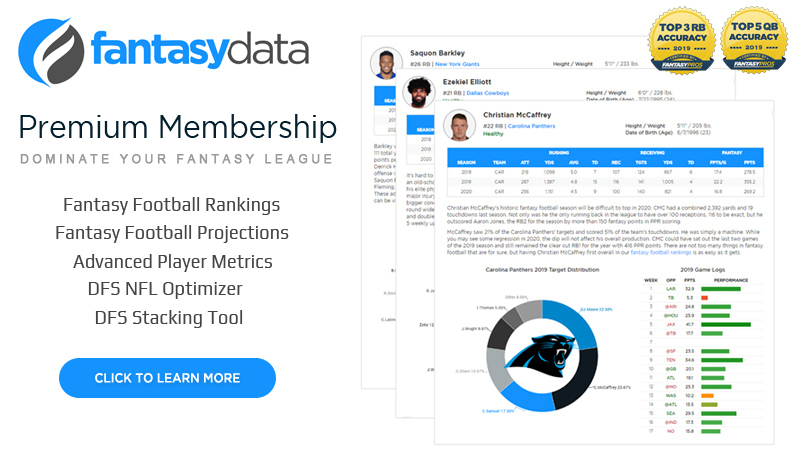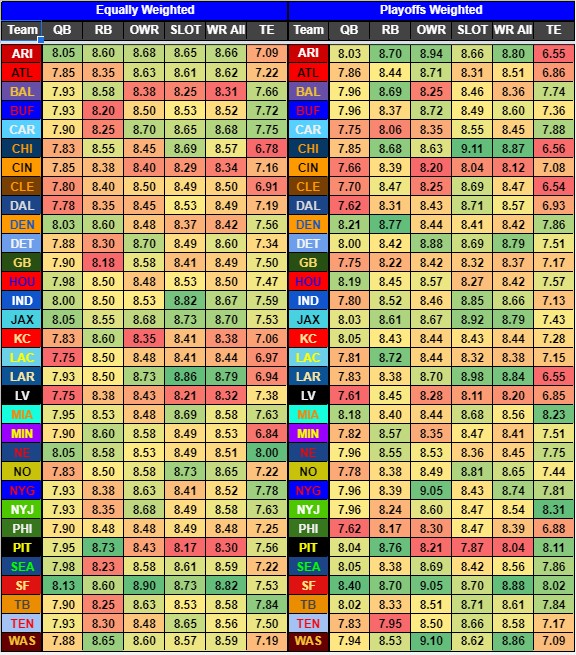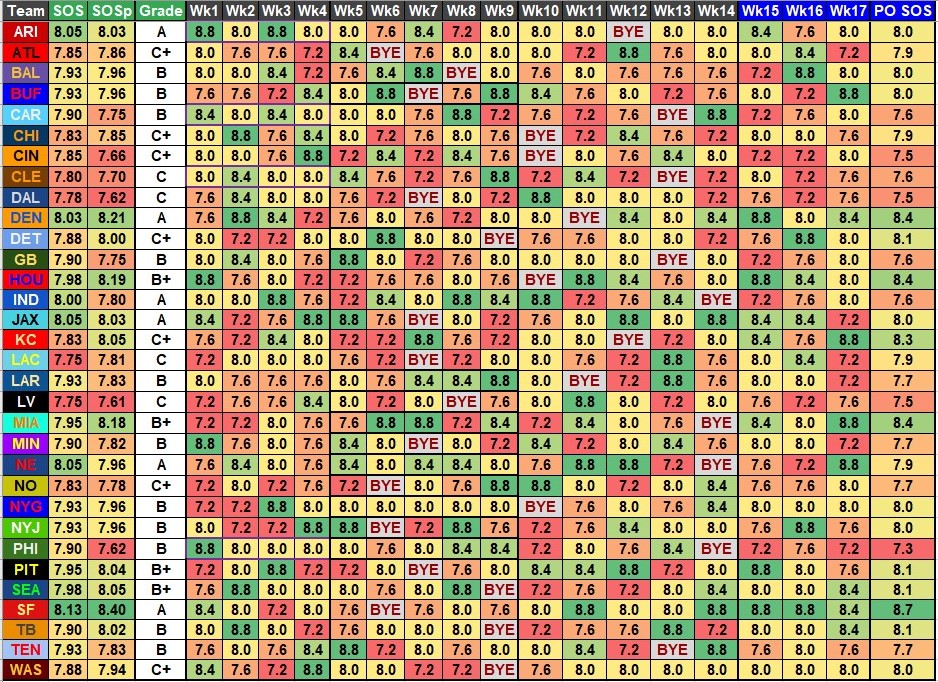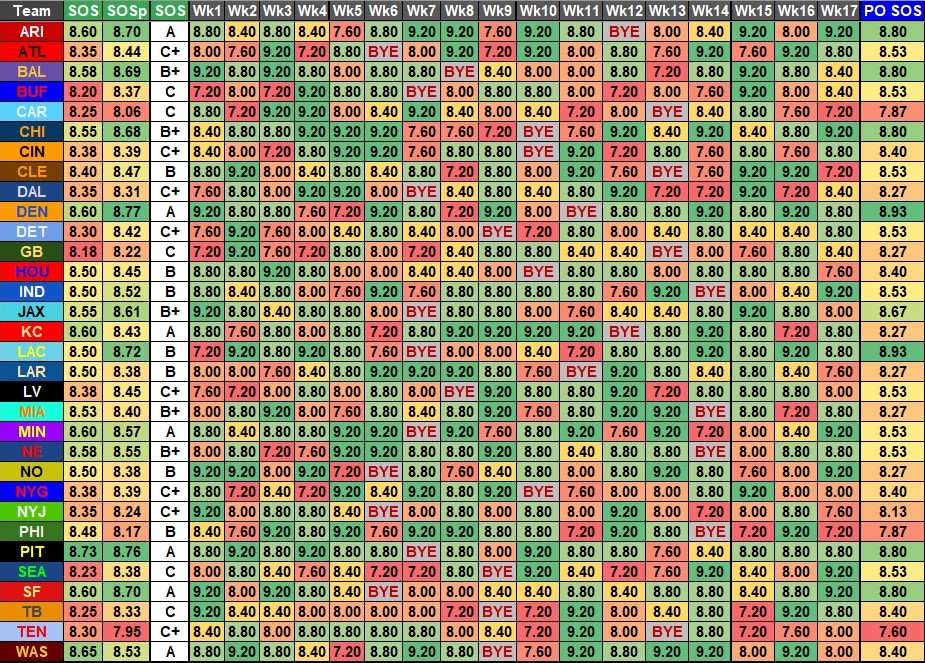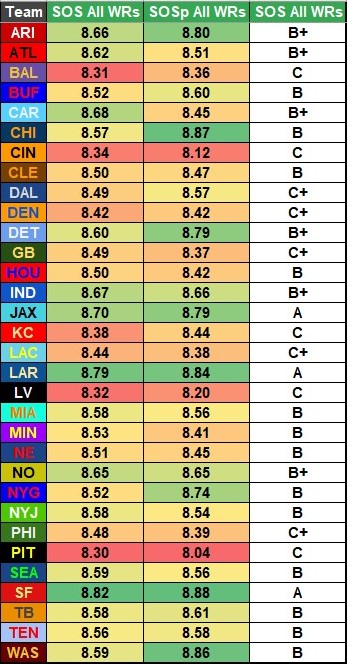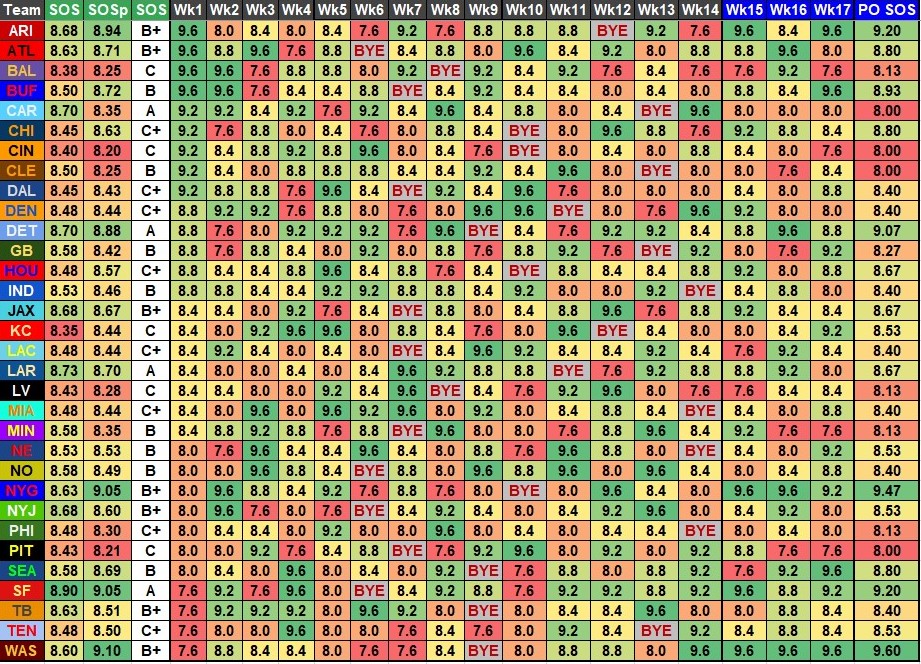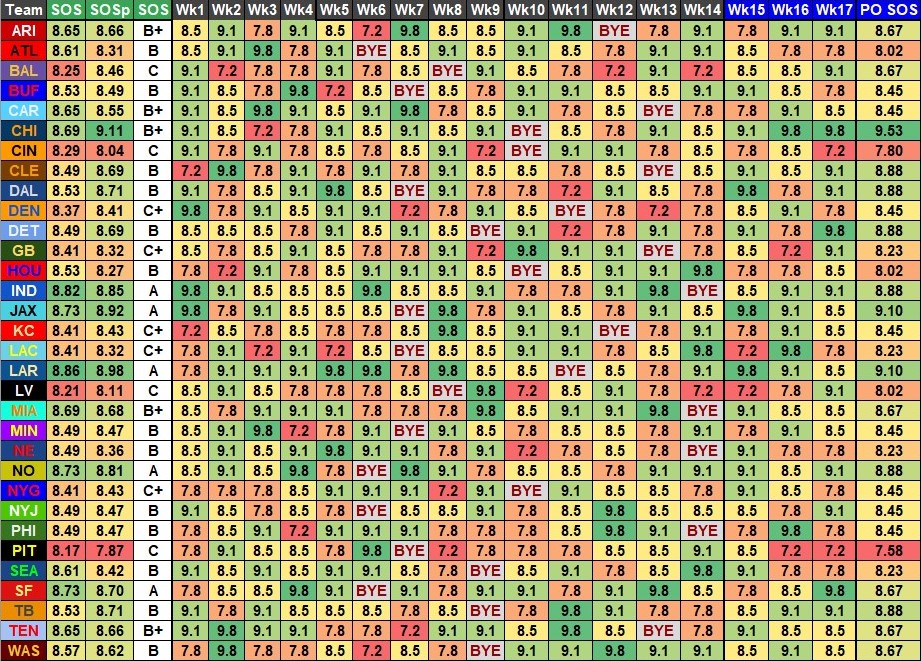NFL Strength of Schedule 2021
As you’re viewing Fantasy Data’s 2021 Fantasy Football Rankings this year, you might notice an SOS column with a letter grade assigned to them. You may wonder how we determined those ratings or what they mean (SOS = Strength of Schedule if you didn’t already know). Well, as the creator of those grades, I can fully explain exactly what they mean and the process it took for me to establish them. You may see other Strength of Schedule ratings or charts across the internet, and if you’re like me you’re probably disappointed to learn they are 100% based on last year’s finishes for each team. Creating an “Advanced SOS” spreadsheet/workbook is a project I have been wanting to do for a few years and this year I was finally able to tackle it. Let’s work through the process together so that when you see those letter grades on our rankings pages you will understand exactly what is represented in that column.
The Beginning of the Process
Where most SOS ranking end was where I started my process. It’s not a terribly tough task to toggle through last year’s data and see who was bad or good at stopping the run or pass. If you’re clever, you can make a fancy chart with team logos as a visual and call it a day. Instead, let’s take that data and start looking for what has changed since then to determine if that data has any relevance in 2021. If you followed my work last year and remember those weekly DraftKings DFS Workbooks, those provide a great start to building a baseline for what we want to analyze and adjust for this year. The screenshot below has many interesting data points to begin the process for determining a 2021 Advanced Strength of Schedule. The data in this chart is what I wanted to use once I got to the reconciliation point of the project to determine how much better or worse a team would be after the majority of the offseason moves have taken place.
The first thing I wanted to do was compare this data to the previous year to see Year Over Year (YoY) improvement or decline. So, I pulled the defensive data from our NFL Team Stats pages and did a simple comparison for Pass and Run Defensive stats. In the Passing Data Chart below, we want to focus on the third box which has the actual YoY Improvement figures (negative numbers indicate the defense got tougher in those categories).
I did this for Run Defense data as well.
2021 Roster Changes
With 2 years of data and a YoY trend, I wanted to determine how many of the players that produced the data were going to be there for 2021. Using our NFL Depth Chart page, I created a spreadsheet with a “Player Continuity” rating system. Teams bringing back the same players (and coaches, but we’ll get to that next) have a greater chance at repeating their prior performance. Productive teams with high continuity ratings are perceived to have already jelled together, and barring injury, those teams shouldn’t make a drastic move up or down from their previous year(s) rankings. The Continuity Chart displays the current starting 11, along with the projected Nickle Cornerback, as well as 1 additional defensive back to account for teams that play more nickel-based schemes. The ratings in the far-right column are color-coded in rainbow order from Blue to Red with Blue being the highest continuity. This chart is a good way to visualize which teams are sticking together and who are making wholesale changes to their defenses this year. Team with new players learning new schemes could start slow as they figure out communication and how to cover their assignments. We might want to target those low-continuity defenses early, especially in DFS.
2021 Coaching Changes
After looking at the continuity of players, I felt it necessary to analyze teams that are replacing their defensive coordinator and/or adopting a new defensive scheme. Teams running the same scheme for multiple years with high player continuity should be expected to maintain their level of play or improve. Teams with new coordinators may have players learning a new scheme and could start out allowing offenses to take advantage of them early in the year. Some teams are replacing a departing defensive coordinator by promoting a coach that was already on the staff last year. I created a formula for each coaching scenario to derive a continuity score from 0 to 9. Then, created a simple 1 through 5 scale to rate the quality of the defensive coordinator based on their historical results.
The chart below shows each experienced defensive coordinator’s results in their first year with the team they are still coordinating, and for the coordinators who are new to their team in 2021, it shows their first-year results with the last team they coordinated. It also shows a 2019 to 2020 YoY trend for the established coordinators as well as their Average Fantasy Points Allowed in both the Passing and Rushing defense categories. The column titled “Tenure Avg FPA Pass/Run” calculates the defense’s average fantasy points against through passing (calculated by QB scoring) and rushing during the defensive coordinator’s current tenure with their team. The last column of the chart shows where each team may have had a soft spot or funnel on defense.
Reconciling the Data
Okay, so we picked up where we left off by looking at the final Matchup Chart of 2020, we established YoY Improvement by the defense, we reviewed roster changes to determine player continuity and ended the data collection process by looking at Defensive Coordinator trends and possible soft spots (or funnels) in their scheme. What we need to do now is reconcile all this data and arrive at a rating for each defense this year then apply that to every team’s 17 game schedule to calculate a Strength of Schedule rating. To do this I compared that final Matchup Chart and where defenses were allowing points and adjusted those numbers based on the other data gathered and adjusted those figures based on roster improvement and coaching changes. Then, I boiled that down to a number rating between 1 and 10, which ended up being more like a 5 – 10 rating which made it easier to assign the letter grades that were requested for this project. Here’s what that final reconciliation looks like.
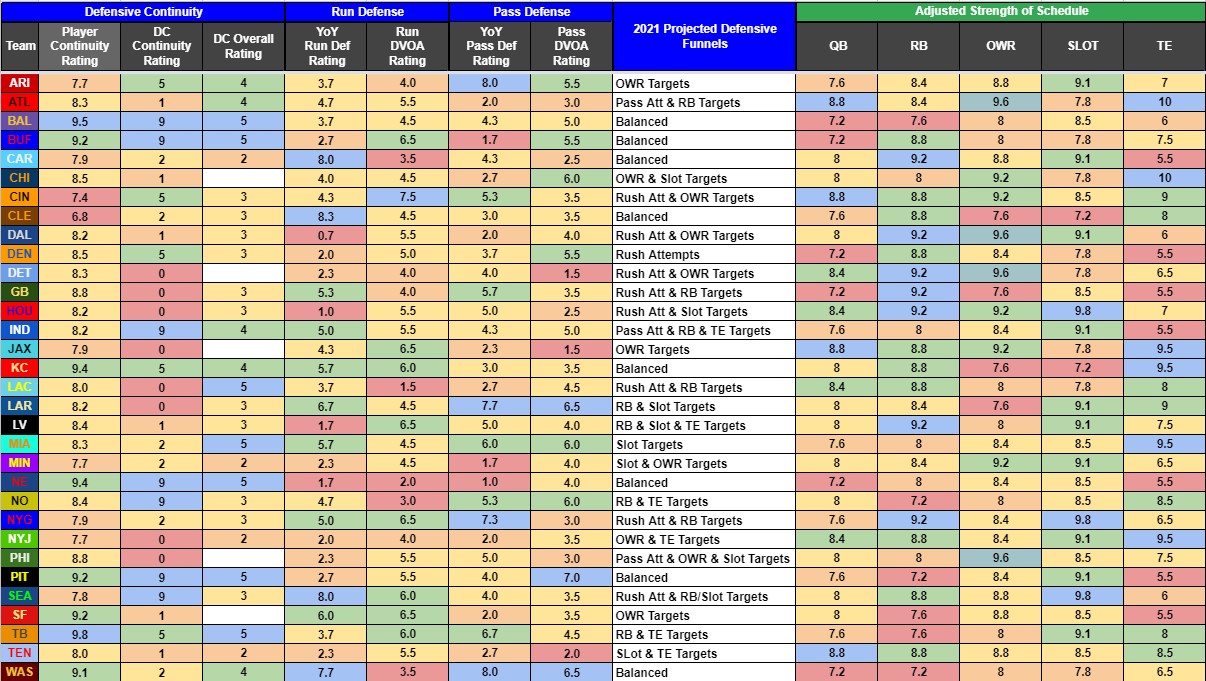
Signup To Read More
Now is a great time to sign up, save big with FantasyData’s 2021 NFL Season Passes
2021 Advanced Strength of Schedule Revealed
After scoring every week for every team’s QB, RB, WR, and TE I was able to calculate the average score of the defenses they face from Weeks 1-17, assuming most formats will not have matchups scheduled for that final week in Week 18. By doing this, it was easy to find the letter grade that needed to be assigned. You may notice a more gradient color scale on this chart than the previous charts. This is because I want this data to have more refinement, a better way to see the significance of the score behind the grade. You may also notice a separate column for “OWR” and “SLOT”. That is because when I started this project I had those two receiver types split out. Currently, Fantasy Data does not differentiate between Outside Wide Receivers (OWR) and receivers that play mostly in the slot (SLOT), but since I had the data from last year that showed each defense’s splits between the two receiver types, I was able to create a rating for each. Since we don’t have that split in our rankings, That won’t show up on our ranking page but you can see it here. So when you see the WR grade on our rankings and know that that player is primarily a slot WR, you might want to refer to this chart for a more accurate grade. Other players, Keenan Allen for example, will split their time between the slot and the outside. In those cases, the standard WR grade on our ranking page will apply.
Another thing you may notice after reviewing this chart is that there are two ratings, “Equally Weighted” and “Playoff Weighted”. The Equally Weighted group counts Weeks 1 through 17 equally in the average. Playoff Weighted uses the Equally Weighted Average and combines it with a separate Playoff score to determine the average. The chart below is an example of how the scores are calculated and illustrates the Playoff Strength of Schedule Score in the last column titled “PO SOS”. This is something I have always done for the SOS charts I make for myself every year. The goal is not just to win the average of 17 weeks, the goal is to win if you get to the playoffs. I like to look at those weeks separate from the fantasy regular season and use it to break ties on draft day.
Pro’s and Con’s of Strength of Schedule Ratings
This article is being written in mid-June, and as we all know, anything can happen during training camp, preseason, and the regular season. Does that mean we should disregard this information or weigh it differently? Well, if you look at this as a worst-case scenario for every team’s SOS, then you’re drafting with the idea that some teams’ schedules may get easier. The flip-side of that is some defenses may turn out to be better than I have them rated here. However, I did my absolute best to adjust for that by embarking on the process illustrated throughout the beginning of this article. In my view, this has me/us drafting for the worst and hoping for the best. So, if I/we decide a player’s talent can overcome the factors that lead to a less than desirable rating, I/we may move him down below consensus but be willing to draft him in case the breaks fall their way.
Position By Position Analysis and Commentary
Let’s go position by position and highlight some of the players we might want to move up/down our boards a bit based on their Advanced Strength of Schedule. Examining the Advanced SOS for each position could also give us ideas when drafting for Best Ball tournaments. Finding a pair or group of players where one/some have easier matchups while the other(s) has a tough stretch could play a role in maximizing scoring in that format. We also may want to compare the weeks (or whole season) schedules of a QB against their Running Backs’ schedule to see what RBs may be in for more work than we might have originally anticipated. The QB chart is posted just above, so let’s start there.
QUARTERBACK
The San Francisco 49ers came out with the softest QB schedule in the league. Their first two games could be a good way for Jimmy Garoppolo to prove himself but the next 4 out of 6 games are where he’ll need to keep any moment he has going. Otherwise, we might see Trey Lance become the starter. Whoever the starter is from Week 10 forward may be a league winner. In Best Ball, we’ll have to spend 2 picks on the “SF QB” while also picking at least one other QB to complete the roster. Other QBs with an “A” schedule: Kyler Murray, Carson Wentz, Trevor Lawrence, and whoever starts for Denver and New England. The New England QB (and I’ve already been drafting as though it’s going to be Cam Newton) is a real steal in DraftKings Best Ball tourneys. That schedule is pretty light from Weeks 2 – 12, then he finishes at home against the Jaguars for FF Super Bowls. The Patriots are going back to that 2-TE recipe that worked when they had Gronk and Hernandez. Scooping Cam and one or both TEs is a cheap stack on DraftKings, right now.
The AFC West didn’t fare well in this exercise with the Chargers and Raiders fielding the lowest scores for their tough schedules. Justin Herbert still has 8 games against opponents with a “B” or better grade for the matchup, so he’s not undraftable. Derek Carr, however, is not a QB I ever intend to draft and that won’t change this year. It’s unfortunate to see Dak Prescott with the third-worst score after his massive breakout to start last season. Like Herbert, Prescott also has 8 games with a “B” or better matchup grade but his fantasy playoffs schedule grades out the lowest. Dak’s schedule has caused me to bump Ezekiel Elliot up the #5 overall spot in my current rankings as a hedge, in case they need to rely on him heavily through some of the tougher passing matchups.
Players that may come out of the gate hot for the first few games are Kyler Murray and Russell Wilson. Murray and Wilson are high fantasy draft capital players but if we’re looking for some cheap, dart-throw guys for Best Ball or guys to target in DFS before the algos have enough data to adjust, then we might want to look at Baker Mayfield, Sam Darnold, and Jalen Hurts. Lamar Jackson has a better first-half schedule than the second half, where weeks 1-11 might be his best stretch of games until the final two FF playoff matchups. Josh Allen has a nice stretch from weeks 4 through 12, then sees the Bengals defense in the FF Super Bowl (Week 17). The Bears have a manageable first 5 games for cheap Best Ball and DFS purposes. The Broncos QB from Weeks 9 through 17 might be solid starters. The Texans QB has a nice stretch from Week 11 (after their Bye week) through the FF playoffs and Super Bowl. Matthew Stafford may take a couple of games to adjust and get over less than ideal matchups, then he has a nice stretch from Weeks 5 through 16, then has to travel to Baltimore for the FF Super Bowl. Tua Tagovailoa has a solid cluster of games from Weeks 6 through 12, then gets a soft playoff schedule. Daniel Jones had a sophomore slump last year but with a “B” or better games from Week 3 on, he’s worth a look late in drafts. The Giants bolstered his pass-catching options by adding Kenny Golladay and Kyle Rudolph, plus he gets Saquon back. Jalen Hurts has a great regular season schedule but that tightens up come playoffs, possibly forcing him to run more for the final 3 games (rushing points score higher than passing points in most formats). Ben Roethlisberger has a nice stretch from Weeks 9 through 16. Tom Brady has a tough, 1st place schedule that opens up for the FF Playoffs. Ryan Fitzpatrick will see 7 straight “B” grade matchups to finish the season and FF Playoffs.
RUNNING BACK
The Pittsburgh Steelers landed on the softest RB Advanced SOS for 2021. Najee Harris is being drafted in the 2nd round on BB10 and DraftKings so we’re not getting any sort of discount, but the Advanced SOS can at least confirm he’s worth the price tag up there. He may be going lower in other formats, in which I would consider him a steal outside of Round 2. Antonio Gibson has the 2nd highest Advanced SOS score and is usually going around the same area as Harris, if not a bit lower. Dalvin Cook headlines a cluster of RBs that tie for the third-highest graded schedule. Cook was already running behind the league-leading offensive line in Advanced Line Yards (per Football Outsiders). Also worth keeping an eye on in that third-highest graded group are Clyde Edwards-Helaire, Raheem Mostert, Chase Edmonds/James Conner, and whoever takes the lead in Denver’s backfield. The Arizona, Denver, and San Francisco backs are all ranked high for the FF Playoffs, with Austin Ekeler, David Montgomery, and the Baltimore group all joining them in the upper tier.
Derrick Henry may find the sledding tougher this year with the worst graded “Playoff Weighted” Advanced SOS but I wouldn’t move him down the board much farther than his current ADP. The addition of Julio Jones will keep defenses from over-crowding to stop him. Christian McCaffery is also looking at a less than ideal schedule making the choice at #1 overall interesting if you weigh this into it. Both Dalvin Cook and Alvin Kamara need to be considered in that #1 pick conversation. Green Bay has the worst “Equally Weighted” Advanced SOS which puts more emphasis toward Aaron Jones over the potential goal-line vulture A.J Dillon for me. Buffalo, Seattle, and Tampa Bay round out the bottom 5 and have avoidable backfields to begin with.
Looking for good RB SOS stretches comes right back to Najee Harris. If the Steeler OL can figure it out this year he should start the season on a tear with 7 straight “B+” or better-graded matchups. Other potential strong starts could come from Dalvin Cook, J.K Dobbins, and the Ravens group, and David Montgomery has a nice stretch from Week 2 through 6. An eye toward the playoffs leads us to Denver and whoever their lead back will be, as we’ll want to have them ready to go for Weeks 12 through 17. Edward-Helaire’s schedule opens up in Week 7 where he’ll have 8 straight “B+” or better-graded games in a row. Weeks 5 through 13 look good for the Patriots backs and Cam. Aside from a 4 game stretch in the middle of his schedule, David Montgomery could benefit from a soft schedule. Ekeler has a sweet playoff schedule with three more “B+” or better games scheduled right before then. Miles Sanders has a nice stretch from Weeks 3 through 13 where he faces 9 out of 11 “B+” or better matchups. In Weeks 9 through 16 we’re going to want to know who the lead back for Las Vegas is as they face 7 “B+” matchups in an 8 game run. Running Backs we might want to consider for the FF Playoffs will come from Arizona, Baltimore, Chicago, Denver, Detroit, Chargers, Pittsburgh, and San Francisco.
WIDE RECEIVER
I broke WR out into two groups, the Outside WRs (OWR) and Slot WRs (SLOT) because I had the defensive data on hand from last year to analyze the split. In this section, I’ll look at OWR and SLOT independently, however, the Overall WR chart used to create the “Grade” for Fantasy Data’s Rankings page is posted above for reference. That chart can also be used for WRs that have a closer to even split between outside and inside alignments. Guys like Tyreek Hill, Robert Woods, Copper Kupp, Keenan Allen, and Jarvis Landry had several games last year where they were almost 50/50 between the slot and the outside. The overall WR chart would be the best one to reference for those kinds of receivers.
OUTSIDE WIDE RECEIVER
THE NFC West may have drawn the softest OWR SOS in the league with the 49ers and Rams drawing the top two spots and the Cardinals joining them near the top with the 5th softest schedule. All 4 teams in the NFC West keep the same offensive systems, too. Getting to see Robert Woods play with an accurate and aggressive QB is going to be awesome for those that draft him in fantasy. Cooper Kupp, Brandon Aiyuk, Deebo Samuel, and of course, DeAndre Hopkins should all catch our attention based on this chart. The Jaguars and Jets OWRs could be worth a look later in drafts as they also drew inviting schedules. The Chiefs and 3 of the 4 AFC North teams hold the bottom 4 spots in the equally weighted SOS group.
Fast starts could come from Arizona, Carolina, Dallas, Indianapolis, Jacksonville, Rams, Minnesota, Jets, San Francisco, Tampa Bay, and Tennessee OWRs. While the top playoff OWRs to keep an eye on will be Arizona, Buffalo, Chicago, Detroit, Jacksonville, NY Giants, San Francisco, and especially Washington. Regarding Washington, their schedule is a bit bumpy but opens up coming down the stretch. If you miss out on drafting McLaurin or Samuel, you might want to try to trade for them during Week 9 if the owner looks like they need some immediate help and could be frustrated with them at that point. Atlanta doesn’t have a particularly great stretch of games but their overall schedule and likely need to play from behind make their receivers (Ridley) interesting. Carolina has a tough final three games for their OWRs, as do Cincinnati, Cleveland, and Pittsburgh could have a tough last two games for the FF Conference Championship and Super Bowl weeks.
SLOT RECEIVER
The Slot WR chart continues with the Rams leading the way. With Cooper Kupp (59.5% slot rate) and Robert Woods (39.2% slot rate) both handling outside and slot duties, both are very attractive draft options this year. The Colts come in right behind the Rams for the softest schedule and will have Parris Campbell returning to man the slot, if not Zach Pascal again. Laviska Shenault has seen a fair share of hype this offseason and he is projected to be the Jaguars slot WR for the third-softest schedule. The Jags tie with New Orleans and San Francisco for that 3rd spot on the SOS chart. Michael Thomas was the leading slot receiver for the Saints for most of the years until Tre’Quan Smith found his way into that role the most last year. The 49ers don’t use a slot WR very often, preferring to use a Fullback or extra Tight End. When they do use a slot, it’s a mix of any and all of their receivers so none of them stand out for this chart. However, they all stand out when looking at both the OWR and SLOT charts. Chicago has the softest final three games for our FF Playoffs. Anthony Miller has been their usual slot guy and as of now is the projected slot heading into 2021. The Rams, Jags, Colts, and Saints all pop when we focus on the playoffs, too. Some Slot WRs that face tough Advanced SOS include JuJu Smith-Schuster, Hunter Renfrow, and whoever lines up there for Baltimore. Tyler Boyd may also be looking at a tough schedule this season, including the final three weeks of the FF season, where JuJu is also ranked low.
TIGHT END
New England signed a couple of stud Tight Ends this offseason and still have a QB that helped Greg Olsen thrive in Carolina. The Patriots may be trying to go back to the days of Gronkowski and Hernandez causing problems for defenses in the middle of the field with their new iteration comprised of Hunter Henry and Jonnu Smith. The Patriots top the TE Advanced SOS and have the makings for a fast start if Cam Newton can jell with one or both of those guys. Speaking of Rob Gronkowski, he and O.J. Howard hold the second-softest SOS this year. The New York Giants land the third-softest schedule and will return Evan Engram along with Kyle Rudolph for 2021. I’ve been taking very late-round shots on Rudolph in some Best Ball drafts, but this is a crowded group of pass-catchers the Giants have and Jason Garrett doesn’t exactly inspire confidence. The Giants were the 4th-worst in passing yards per game, despite throwing the 2nd-most passes per game last year. The Panther and Bills come in 4th and 5th but neither has a truly dominating TE to target. Dan Arnold had some moments with the TE ignoring Cardinals last year, so perhaps D-Arnold can find a rhythm with Darnold in Carolina. Mark Andrews has the 6th-softest schedule and does play in an offense that utilizes the TE regularly. The tougher TE schedules go to Chicago, Minnesota, Cleveland, the Rams, and the Chargers. We can use this info to bump the receives up our boards if the TEs are finding it hard to get open. Come FF Playoffs, we’ll want to keep an eye on Mike Gesicki, Chris Herndon (if you like to play with fire), Eric Ebron, George Kittle, and Gerald Everett as possible league winners at the position. Tight Ends to be leery of during this time will be Austin Hooper, Tyler Higbee (more Woods/Kupp, please), Cole Kmet, and Darren Waller (I’d be less pessimistic with him).
SUMMARY
Creating an Advanced Strength of Schedule takes a lot of work and I am satisfied with the results of this project. Although Strength of Schedule is only a piece of the puzzle it can help us break ties within tiers of players, or open our eyes to players we may be overlooking a bit. We can also use it to see what positions on each team may face a tougher schedule than other positions and consider moving up other positions from that team to compensate for it. For example, the AFC West teams may have a tougher time passing than running this year, therefore we might want to consider their Running Backs as pivots to the passing game. Conversely, Green Bay, Buffalo, and Seattle may have a hard time running the ball and may be forced into more pass-centric game plans. Another thing we can do with this information is use it to highlight players that have soft schedules during times hold-over players (Dynasty/Keeper Leagues) or players we have already drafted (Best Ball/Re-Draft) have tough stretches and try to maximize the productivity of our roster(s). For DFS, we can use this info to our advantage early in the season before projection sites and algos have adjusted to the 2021 data. Those sites will likely be running projections off of last year’s data without any adjustments for the first few weeks. Thanks for reading, and I hope this helps.

